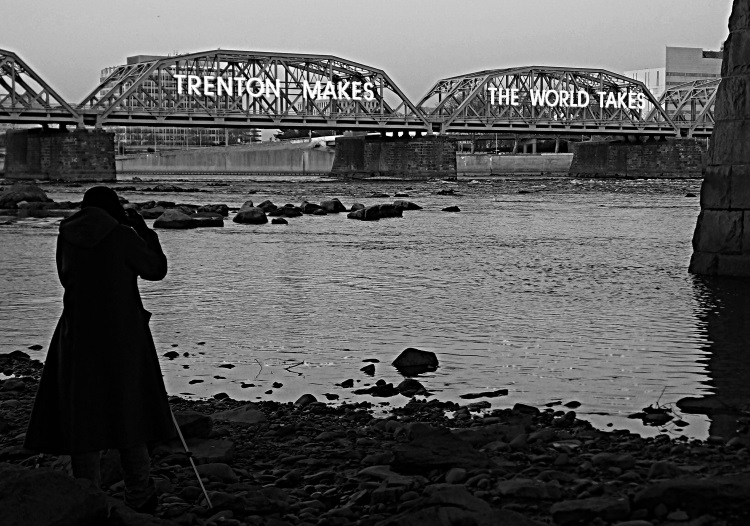 |
From the Night Factory
48. And I
Thought of the Bridges
The massive red brick building was a machine shop, long
ago gutted of machines and tools. That night it was
being used as a gallery and a stage for performance art.
At the hour of our visit the crowd was generally young
and grungy, dotted with a few out-of-place
night-clubbers in their disco gowns. The art displayed
interested me less than the 52,000 square foot interior.
A second floor ran the entire length of the building
like an inside balcony. On that second floor, I observed
old equipment still in place, large flywheels suspended
from the ceiling to be spun by belts in an age before
electricity. Access was not allowed.
Trenton’s annual Art All Night is a twenty-four hour
event that this year ran from three o’clock in the
afternoon on Saturday, the 20th June, until three
o’clock in the afternoon on Sunday, nonstop. Ms Keogh,
my more significant other, very much wanted to attend,
and we were there at three o’clock in the rainy morning.
The event was held at the old Roebling Wire Works. John
Augustus Roebling was the inventor and manufacturer of
the steel wire rope, the suspension cable used in
suspension bridges, most famously in his own design and
construction of the Brooklyn Bridge.
My friend Skip came to mind, how we argued in letters
about which was more beautiful, the Brooklyn Bridge or
his favorite, the Golden Gate Bridge. The Golden Gate
Bridge is also constructed of Roebling cable. But
bridges are like music, you can have no favorite except
for the duration of a mood, and sometimes you forget a
favorite until it arrives to remind you and put you in
that mood. It was in that moment the subject for this
essay came to mind.
The small town of
Morrisville, Pennsylvania is braced to Trenton, New
Jersey by four bridges across the Delaware River. This
part of the river is known as the Falls of Delaware.
Here the river is between 900 and 1,000 feet across and
for a stretch of about two miles it is shallow and
filled with rocks. It was a barrier to the ships of the
Dutch West India Company. They established a trading
post on the Pennsylvania side in 1624, what would become
Morrisville. This shallow portion of the river was a
barrier to John Fitch, inventor of the steamboat, who,
steaming up from Philadelphia, could bring his craft no
further in 1790. The water flows rapidly between
Morrisville and Trenton. It is the fall line, where the
Piedmont Plateau meets the Coastal Plain and the river
drops eight feet. It made for a good place to build
water-powered mills. It is as far as the Atlantic tide
brings seawater. It is a good place to build bridges.
Another reason this was a good place to build bridges is
because Morrisville and Trenton are perched on a direct
line between Philadelphia and New York. It became the
first highway for the colonists, tracing a still older
Native American trail. It was just below the Falls the
first ferry across the Delaware was established.
Eventually that ferry was bought by Paddy Colvin and
Colvin’s Ferry would become the original name of
Morrisville.
Paddy was there to help General George Washington in the
early days of December 1776. Washington’s army was in
retreat from New York with Major General Charles
Cornwallis in pursuit. Before Cornwallis reached the
river, Colvin had seen to it that all available boats
were on the Pennsylvania side of the river, out of
reach. Later that same month, Christmas Day, Washington
would cross back and take by surprise the Hessians, a
mercenary component of the British army garrisoned in
Trenton. This victory was the pivotal moment in the
Revolutionary War changing the balance of the war in
favor of the Colonies.

Morrisville-Trenton Railroad
Bridge
The first of the four bridges one
reaches swimming upriver is the Morrisville-Trenton
Railroad Bridge. By all appearances, it was built by the
Romans, a long array of ancient stone arches. However,
the Romans never made it to this continent and the
bridge was built in 1903. It took a couple of years
longer to build than planned because of several floods
the engineers had not predicted. It was not the first
railroad bridge to cross the river here, but when the
previous railroad bridge was to be abandoned, it was a
chance to build in stone, which is more solid and
requires less maintenance than steel. The bridge is a
handsome brute built for the ages like a mountain.
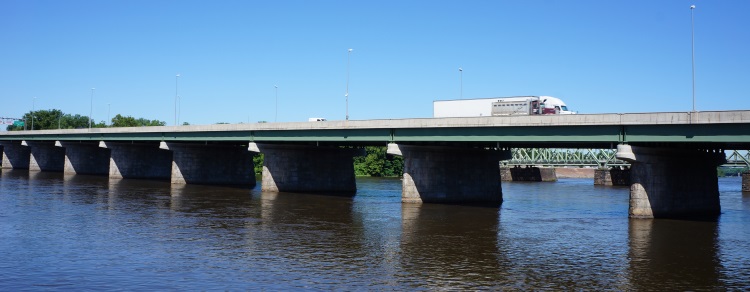
The
Trenton-Morrisville Toll Bridge
The second bridge is a few hundred feet away, green girders attached to piers of granite-faced masonry. It is the ugliest of the four bridges. Utilitarian, the concrete deck plopped into place, this is the Trenton–Morrisville Toll Bridge. It is forever visibly corroding and deteriorating, and not in the charming way of Japanese aesthetics, wabi-sabi. This unadorned bridge represents the pragmatic plainness of the Eisenhower era in which it was built, forgettable relicts of a Philistine age best remembered in black & white. It is the only toll bridge of the four. When I began commuting across this bridge, there was a dime toll each way. The toll is now one-way, westbound into Pennsylvania, and if you don’t have an E-Z Pass, it is a dollar. For that reason, plenty of people take the next bridge up when traveling west.

Lower Trenton Toll Supported
Bridge (Ms.
Keogh in foreground)
That next bridge, another
few hundred feet further upriver, was the Lower Trenton
Toll Supported Bridge, built in 1806, the first bridge
built across the Delaware River. Using a technology
favored for covered bridges, the Burr arch truss,
Theodore Burr designed this unique bridge of laminated
wood arches from which were suspended chain link to hold
the deck. And it was covered! The bridge was acquired in
1834 by the railroad to complete an uninterrupted train
line from Philadelphia to New York, but because the
bridge was made of wood, at that point in the journey
the rail cars had to be hauled across by horses.
Reinforced a year later, locomotives could share the
bridge with horse-drawn wagons.
Wooden bridges burn and at least one fire had been
caused by a locomotive. In 1875, an iron truss bridge
was built for the railroad adjacent to the wooden bridge
on extended piers. In 1876, the wooden bridge was
converted to iron truss. In 1892, the piers were
extended again to carry more rails. In 1898, iron was
replaced with steel in the spans holding the railroad
side of the bridge. In 1918, the railroad sold the
bridge to Pennsylvania and New Jersey and a year later
it became the Lower Free Bridge. However, the present
Warren truss bridge, built in 1928, has been known by
locals as the “Trenton Makes” bridge since 1935, when in
large glowing letters the words TRENTON MAKES – THE
WORLD TAKES were attached to south side. It is there for
all the passers-by to see as they drive across the
Trenton–Morrisville Toll Bridge or are riding the rails
on the Morrisville-Trenton Railroad Bridge. The iconic
sign reminds the older locals of a time when the city
was famous for industry and manufacturing. For the
passers-by, this city, not popular with tourists, is a
familiar milestone on their trips to greater cities.
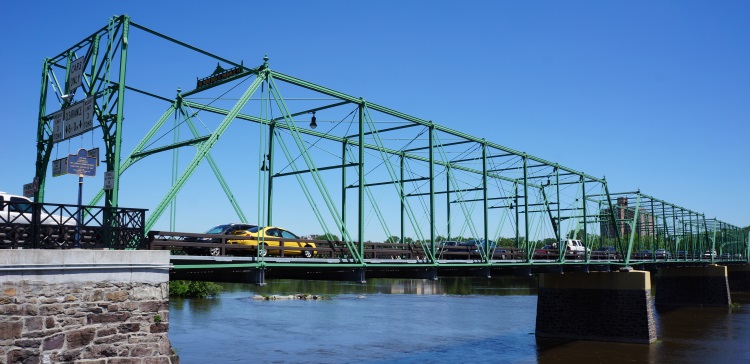
Calhoun Street Bridge
Now we arrive at my
favorite bridge, the last of the four uniting
Morrisville with Trenton. It is several thousand feet
farther upriver. This is the Calhoun Street Bridge, a
Pratt pin-connected truss bridge, a delicate tracery
painted verdigris-like green. So fine are the struts,
chords, and bracing you can forget to see the bridge and
admire the sky, the rocks in the river, the capital city
downriver with the gold leaf cupola of the statehouse,
or the thickly green trees upriver crowding the
riverbanks. Crossing on motorcycle, the river is visible
through deck’s grating beneath your feet. Then, if you
notice the bridge itself, it invites study. The eyes
will find doily-like accoutrements in corners,
decorative plaquettes in the webbing, and finials atop
the ends of the truss.
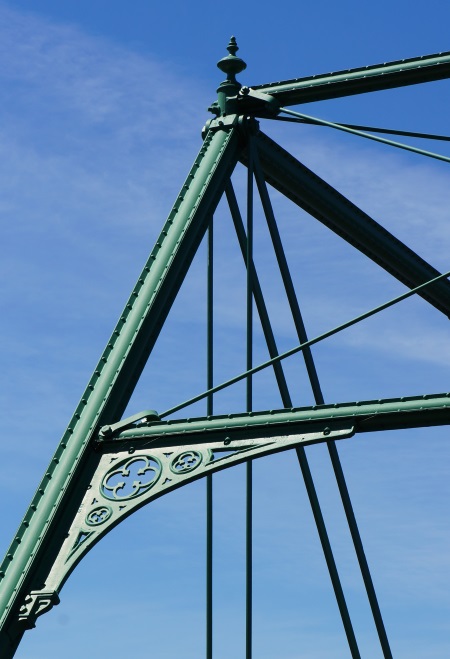
Instead of flat, fat, cast iron columns, the truss is constructed with the famous Phoenix column, four sections joined to form a cylinder, riveted along a lip that runs the length of the seams.
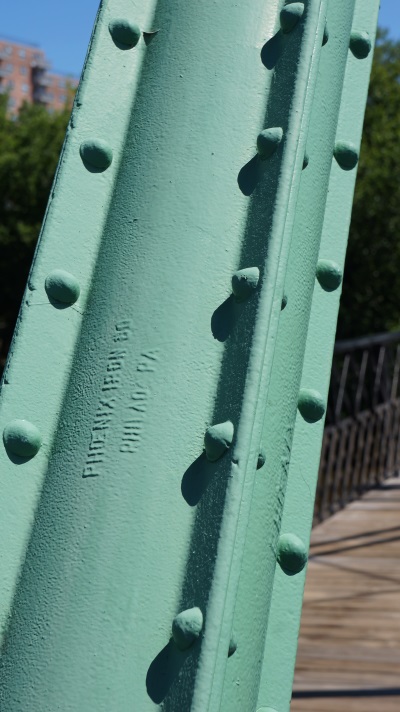
What is most unfortunate is
the disruption to the bridge’s aesthetics by the
addition of steel uprights to the inclined end posts
when approaching from the Morrisville side. This later
addition doesn’t seem to have any structural purpose and
is only there to hold a battery of signs declaring
clearance, weight limits, speed limits, and not to ride
your bike or a horse across. Because of it, you are
likely to fail to observe the plaque that crowns the
entry to the bridge. It reads, “THE PHOENIX BRIDGE CO.
PHOENIXVILLE. PA.”
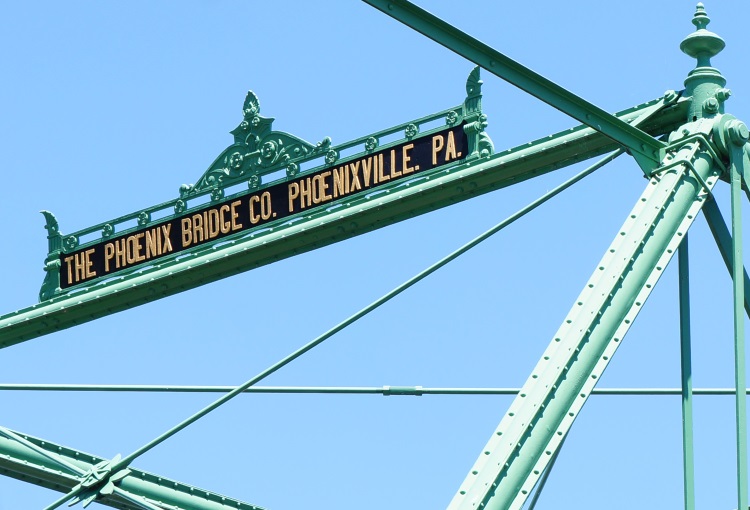
The Phoenix Bridge Company
was organized in 1864 as a division of the Phoenix Iron
Works, which was founded in 1790. The Phoenix Bridge
Company, which is now defunct, built almost 1,400
bridges and as far away as China. This particularly fine
example connecting Morrisville to Trenton was built in
1884. It was not the first bridge at this location.
The City Bridge was a covered bridge with a toll, built
in 1861. It was destroyed by a careless cigar smoker in
1884. The new Calhoun Street Bridge was built on the old
piers and abutments of the City Bridge in 60 days by 83
Phoenix bridge workmen. The toll was discontinued in
1928. A trolley line used to cross the bridge until
1940. The bridge also bore the honor of the Lincoln
Highway, the first transcontinental road in the United
States, built in 1913 and stretching 3,389 miles from
Times Square in Manhattan to Lincoln Park in San
Francisco. The Calhoun Street Bridge and the earlier
mentioned Morrisville-Trenton Railroad Bridge are both
on the National Register of Historic Places, as well
they should be.
I have crossed three of these four bridges a thousand
times. Not the Morrisville-Trenton Railroad Bridge. I
believe I have crossed that bridge only once and that
was because I slept through the Trenton stop and
continued on towards Philadelphia before the conductor
roused me. There will be numerous crossings yet before I
depart for the United Kingdom in less than two months’
time. Then they will be memories and rare will be the
visits. At least I can say I didn’t take them for
granted.
Mr Bentzman will continue to report here regularly about
the events and concerns of his life. If you've any
comments or suggestions, he would be pleased to hear from you.
Selected Suburban Soliloquies, the best of Mr Bentzman's earlier series of Snakeskin essays, is available as a book or as an ebook, from Amazon and elsewhere.
